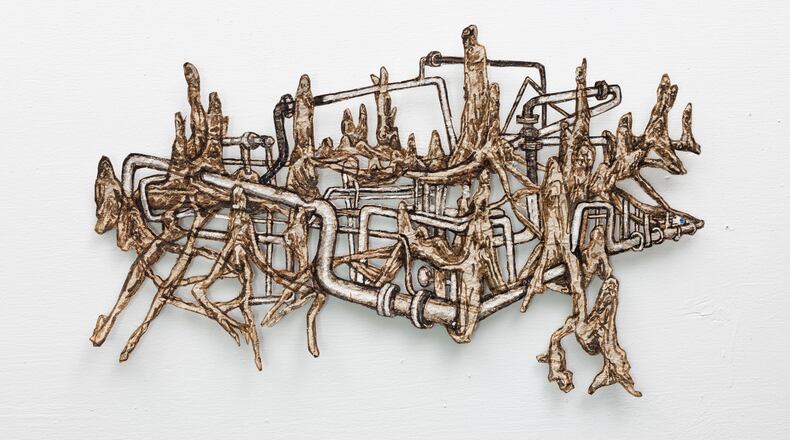This story was originally published by ArtsATL.
The year has started with shows exploring the South’s many ethnic identities, its historical and environmental issues and the personal identities of the individuals who live in the region. There are also shows that allow close study of purely formalist aesthetic topics.
‘The Space Between’ at Perimeter College’s JCLRC Gallery
The formalist explorations begin with a show that also illuminates personal identities, although this aspect is distinctly oblique. “I, We, and the Space Between,” at the JCLRC Gallery at Perimeter College through Feb. 29, features an 18-foot-long collaborative scroll plus solo works by six well-known Atlanta artists (Lisa Alembik, Eilis Crean, Erin Dixon, Stephanie Kolpy, Debrah Santini and Stephanie Smith).
Credit: Photo by Jerry Cullum
Credit: Photo by Jerry Cullum
The artists are friends whose styles are extraordinarily diverse but united by subtle shared points of sensibility. The diversity of individual styles and preferred media makes the extraordinary achievement of the single collective artwork all the more remarkable.
‘Interconnect’ and ‘Collective Telling’ at Echo Contemporary Art
At Echo Contemporary Art through Feb. 17, Jacob O’Kelley has curated ”Interconnect,” subtly related work by Xenia Aims, Amanda Banks, Eliza Bentz, Leslie Drennan, Cheyenne Hendrickson, Sayma Hossain, Casey May McGuire and Raymond Padron, positioned to “articulate nuanced dialogues about our relationships with nature, society and the spaces we inhabit.”
This ambitious exploration only appears formalist because of its proximity to ”Collective Telling: Southern Rooted Perspectives on Place, History + Emergence,” curators Heather Bird Harris and Jennifer Williams’ adjacent exhibition delving into ethnic identities and environmental activism, also through Feb. 17.
The exhibit features an extraordinary collection of 19 Southern-born or Southern-rooted artists. By curatorial design, most of them are based in or have roots in New Orleans and Atlanta.
Credit: Heather Harris
Credit: Heather Harris
These artists find visually engaging ways to explore diverse topics, from Shana M. griffin’s previously untold stories of Black women displaced from housing in New Orleans and Hannah Chalew’s recycled-component works on paper symbolic of environmental issues surrounding the Crescent City to Jeffery Darensbourg’s poems written in the indigenous language of Ishakkoy.
The exhibit also features indigenous artworks by Johnnie Diacon and Hotvluce Harjo that interpret the ceremonies their Muscogee-Creek nation brought to Oklahoma after being forcibly removed from Georgia.
The remainder of the show contains far more topics and artworks than can be covered here. For example, there is a mixed media series by Alabama artist Jenny Fine regarding the ways in which Southern cooking was and is regarded in middle-class households as “women’s work.”
Most of the art is for sale. One that is freely given away is Hannah Palmer’s “Department of Urban Springs Brochure,” a convincing but fictional informational guide to the long-concealed natural springs in metro Atlanta that were restored (her “guide” tells us) to renewed glory in 2024 and 2025 as Georgia State Parks. On Feb. 17, Palmer will lead a walking tour of the sites of these still very much covered-over water resources.
Other events associated with “Collective Telling” are Ann Hill Bond’s upcoming conversation with Kiyomi Rollins (Feb. 15) with a performance portraying 1906 Atlanta Race Massacre victim George Union Wilder and a closing reception on Feb. 17, including artist talks by kai lumumba barrow and griffin.
‘Meaning-Making’ at at Spalding Nix Fine Art
Also deserving of attention are the interpretations of meaning, memory and mark-making by the four artists (Esteban Patino, Shannon Davis, Erin Dixon and Susan Lenz) in ”Meaning-Making,” at Spalding Nix Fine Art through March 15.
Credit: Courtesy of Spalding Nix Fine Art
Credit: Courtesy of Spalding Nix Fine Art
Patino extends his well-known mixture of self-created alphabet and allusions to the visual art of the ancient Americas in affirmation of his personal heritage, in ”Riddle.” It’s a large canvas that outstrips his more familiar works in the rest of the gallery.
Dixon continues subtle mixes of memory-oriented figuration, Lenz uses small vintage objects (bottle caps, View-Master reels) to create evocative mandalas and Davis contributes surrealist photographs that reveal the alien qualities of “Southernness” as she was expected to learn it years ago as a newly arrived northerner. Davis’ ”Controlled Burn” is also summed up in a matchbox-shaped and sized artist’s book that has been collected by museums.
Linda Mitchell at Thomas Deans Fine Art
At Thomas Deans Fine Art, Linda Mitchell’s ”Secrets” (through Feb. 17) extends her thematic explorations of consciously anthropomorphized animal nature in paintings on canvas and works on paper mounted on panel. They contain the results of “a year of personal meanderings on paper.”
These meanderings also resulted in remarkable prose poems written inconspicuously on the works themselves or on the wall labels that accompany them. They form the text of an accompanying artist’s book that elegantly transcends the genre of exhibition catalogue.
::
Dr. Jerry Cullum’s reviews and essays have appeared in Art Papers magazine, Raw Vision, Art in America, ARTnews, International Review of African American Art and many other popular and scholarly journals. In 2020, he was awarded the Rabkin Prize for his outstanding contribution to arts journalism.
Credit: ArtsATL
Credit: ArtsATL
MEET OUR PARTNER
ArtsATL (www.artsatl.org), is a nonprofit organization that plays a critical role in educating and informing audiences about metro Atlanta’s arts and culture. Founded in 2009, ArtsATL’s goal is to help build a sustainable arts community contributing to the economic and cultural health of the city.If you have any questions about this partnership or others, please contact Senior Manager of Partnerships Nicole Williams at nicole.williams@ajc.com.
About the Author
Keep Reading
The Latest
Featured






